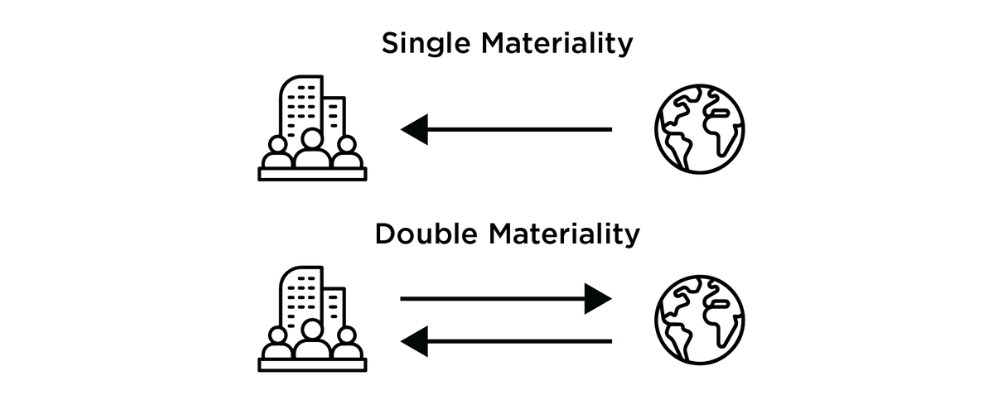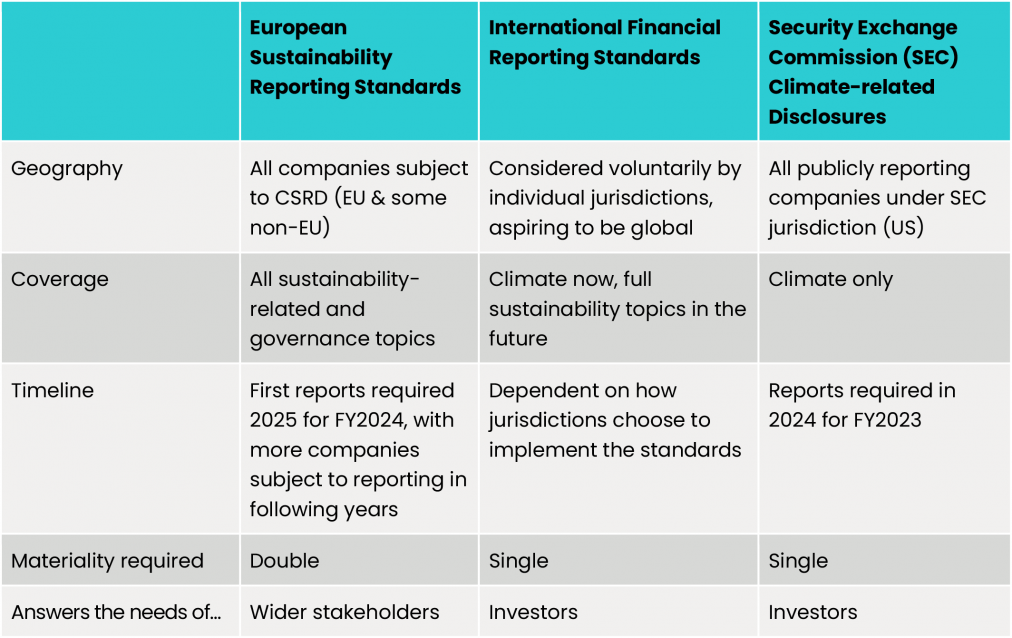A Guide to Materiality
Materiality helps companies enhance their long-term sustainability, mitigate risks, and build stronger relationships with investors, customers, and employees.

Senior consultant in our London, UK team, Helen has a background in social and environmental impact, communications and stakeholder engagement.
A materiality assessment is an essential concept for organizations to identify key sustainability issues and understand where they can make progress. More than that, materiality is a vital part of any organisation’s sustainability strategy and reporting, ensuring their efforts, money and time are focused in areas of greatest impact.
Defining Materiality
The concept of materiality comes from the financial sector where it relates to information that is ‘material’ to views or decisions about a company. Today, materiality is also an integral component of sustainability strategy and reporting.
It stems from the idea that not all sustainability topics are of equal importance for an organisation to address. Instead, businesses should prioritise their actions (and therefore their reporting) on tackling issues and topics that are of material importance––ie have a significant impact on society and the environment and/or present a significant or potential financial risk or opportunity for the business.
A materiality assessment is therefore the process for organisations to identify the most important sustainability issues to address and report on, providing all stakeholders with more meaningful and relevant information regarding the impact of the business.
While every business should have sustainability at the top of its agenda, not all environmental and social issues matter equally to different companies. For example, a tech company will not be as concerned about food security as it is about supply chain disruption, while a recruitment agency will be more invested in diversity and inclusion than energy efficiency. Similarly, a tech company is in a strong position to positively influence sustainable practices around the mining of rare earth materials, while a recruitment agency can play an important role in driving positive outcomes for workers’ rights.
What you’ll notice from this lengthy description is that the concept is not clear-cut and is open to interpretation depending on which stakeholders are being considered, and secondly, what impact is defined to be.
In this article, we’ll explore these two factors and provide an overview of best practice materiality that is in line with what the world needs, before providing an overview of how this relates to current and upcoming reporting standards and legislation around the world, including the International Sustainability Standards Board, the EU’s Corporate Sustainability Reporting Directive (CSRD), and the US Securities and Exchange Commission (SEC).
Types of Materiality: Single vs. Double
As mentioned in the introduction, a key factor that influences what factors are determined material for an organisation is how you view the relationship between environmental and social issues and the organisation.
There are two ways of viewing this relationship:
- Considering the Financial Materiality of different topics (‘outside-in’ perspective) i.e. the degree to which different sustainability issues impact the profitability and performance of the organisation
- Considering the Impact Materiality of different topics (‘inside-out’ perspective) i.e. the degree to which the organisation impacts society and the environment
A single materiality approach will look at the relationship between the organisation and different sustainability topics with only one lens (Financial Materiality) i.e. what social and environmental topics do or might impact our company (positively or negatively)? Relevant stakeholder views here might be narrowly interpreted to be those with a financial interest in the company: investors and shareholders, analysts, and senior leaders.
A double materiality approach will identify material topics by considering both relationships––not only what social and environmental topics impact our company, but (more importantly) what impact our company has on society and the environment. Here, relevant stakeholders include a much broader group of anyone potentially affected by the company’s operations, from communities local to the company’s operations, its employees and suppliers, to wider society, future generations, and nature itself.
By adopting an ‘outside-in’ as well as an ‘inside-out’ approach to identifying topics of priority to the organisation, it ensures that it is managing its impact on a broad spectrum of relevant stakeholders’ rights and requirements, not just its shareholders!

Best-Practice Materiality
For an organisation to truly take action in line with what the world needs, it should consider the impact of the organisation on all environmental and social issues, as well as the impact of these issues on the business: the double-materiality approach. Good practice would also be to consider the changing impact of issues over time. This is called Dynamic Materiality.
Materiality and Sustainability Reporting
Materiality and reporting are inextricably linked as the material topics defined by conducting a materiality assessment inform what you manage as a priority and therefore what you report on. Different reporting standards have different expectations for how developed an organisation’s materiality assessment should be…
- Some, such as the new International Financial Reporting Standards (IFRS) (developed by the International Sustainability Standards Board (ISSB)) require companies to ‘disclose material information about the sustainability-related risks and opportunities that could reasonably be expected to affect its prospects’––ie a single-materiality approach that assesses risks and opportunities to investors of the company.
- Others, such as the new European Sustainability Reporting Standards (part of the CSRD) require companies to ‘include in the management report information necessary to understand the undertaking’s impacts on sustainability matters, and information necessary to understand how sustainability matters affect the undertaking’s development, performance and position.’ This is a double-materiality approach that considers risks, opportunities and impact on all stakeholders.
The table below lists the key international and regional reporting standards that will be impacting businesses across the world, and the type of materiality required as part of meeting these standards:

Benefits of Materiality Beyond Reporting
A meaningful materiality assessment is more than just a compliance exercise…and the benefits it can deliver go beyond meeting investor needs. The assessment requires engagement with your clients, your customers, your employees, and other important stakeholders to fully understand your organisation’s impact. This creates a deeper understanding of wider stakeholders’ needs and new opportunities for collaboration.
In the short term, the output of the assessment can inform communications strategies, ensuring you’re avoiding greenwash and speaking authentically and honestly about your commitment to environmental and social impact. In the longer term, materiality assessments should lead to deeper leadership discussions about what ‘value’ means to the company (beyond just profit), resulting in rigorous examination and innovation around fundamental business models.
What’s Next?
Now that you have identified your most material impacts, it’s time to take a strategic approach to improving those impacts aligned with planetary limits and social thresholds.
You need goals, objectives and targets. The best sustainability strategy will start with bold, motivating goals in line with your vision of the world. Add to those some clear objectives which describe the measurable contribution towards achieving those goals; and quantified targets and metrics that evidence your progress in meeting those objectives. You’ll then have data to support your stories of working towards those goals in your annual impact report.
Ready to understand and manage your impact, and report effectively? We’ve already started guiding companies through a CSRD-compliant double materiality assessment in line with the ESRS standards, helping them to build more resilient businesses. Get in touch to discuss what this could mean for your organisation.
